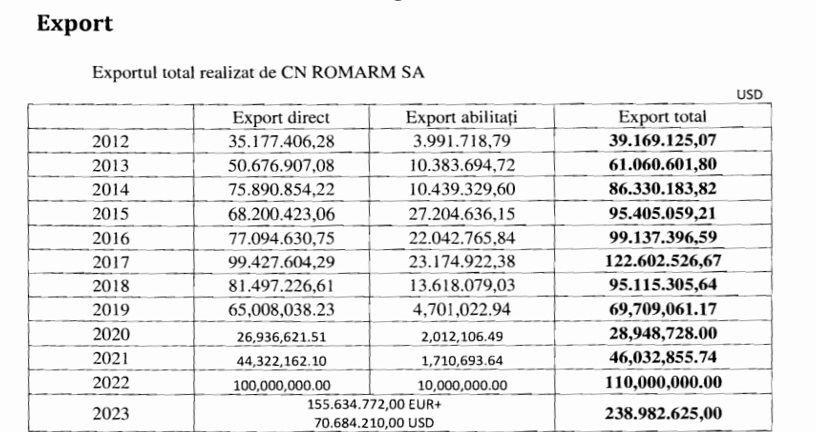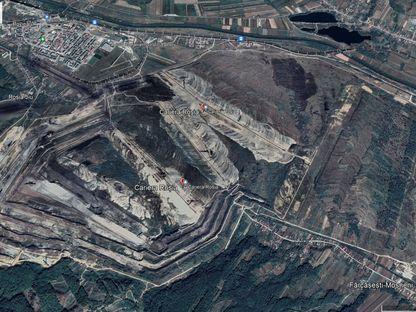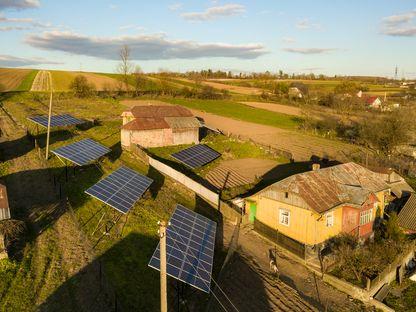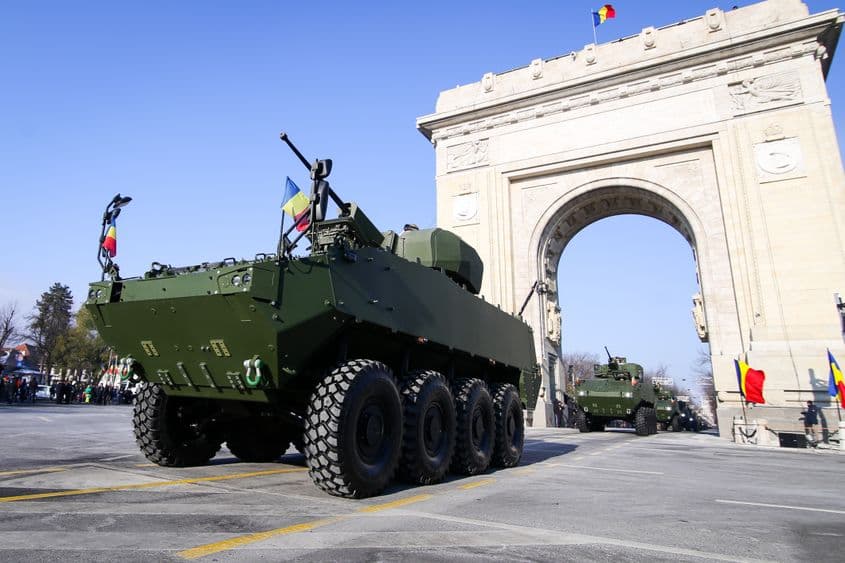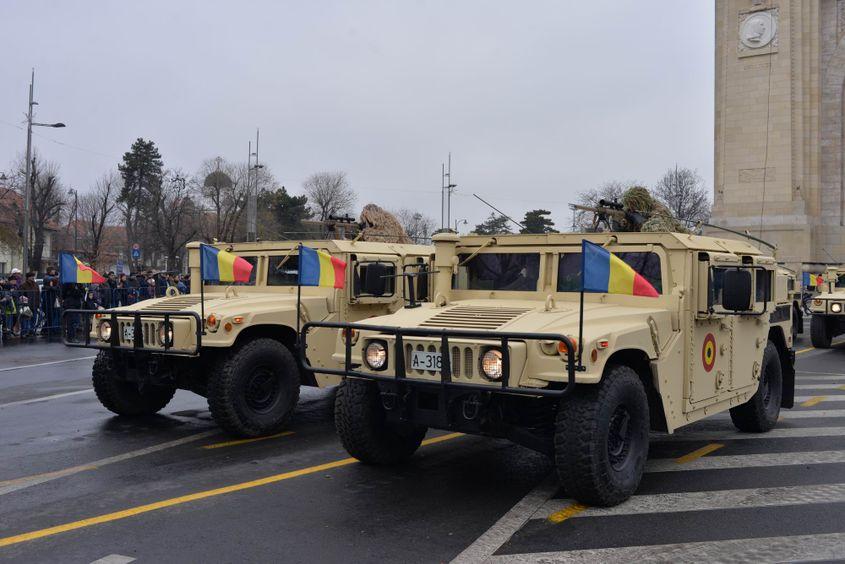Oficialitati participa la evenimentul de deschidere a BSDA 2024, in Bucuresti, 22 mai 2024. Inquam Photos / Octav Ganea
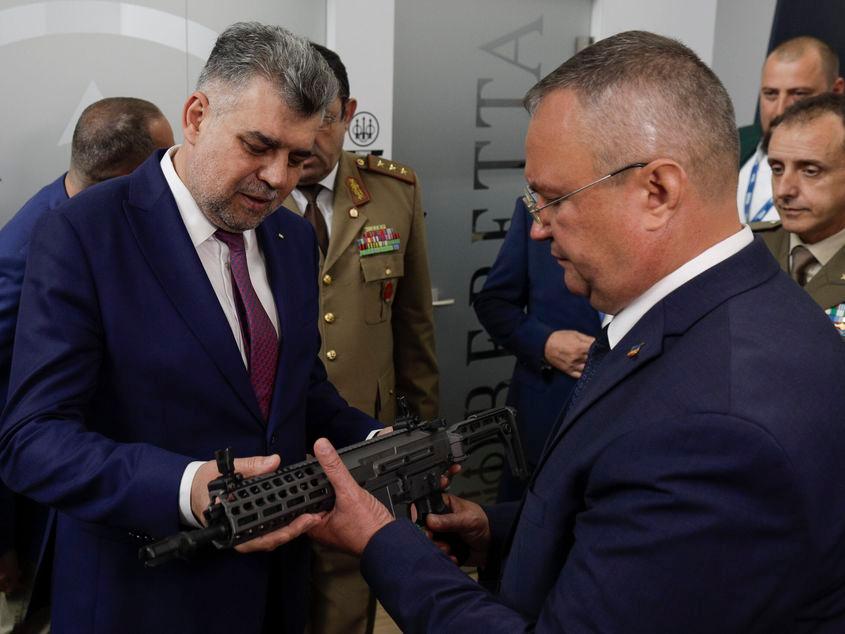
Oficialitati participa la evenimentul de deschidere a BSDA 2024, in Bucuresti, 22 mai 2024. Inquam Photos / Octav Ganea
23/08/2024
Ceaușescu's Ghost Haunts Romania's Weapons Factories: Run by Ex-Cemetery Managers, Using Powders from a Pro-Putin Country
Romania’s defense industry is, above all, a formidable time machine: once through the gates of an arms factory, a visitor is likely to travel back in time and teleport, for instance, directly into the "Golden Age."
A visitor who pays close attention to details will discover a world frozen in time, still haunted in places by the ghost of Nicolae Ceaușescu, whose shadow continues to loom over the halls, workbenches, and workshops that have remained—in the vast majority—unchanged for more than 30 years.
This is how, 20 years after joining NATO, Romanian soldiers are still parading with Kalashnikov-type weapons that use Soviet calibers, produced by the "national defense industry" to the production standards of the 1960s.
Romania has a defense industry with two speeds: a minority that is modern and fully privatized, and a majority that is state-owned, stuck in the limbo of transition, with outdated and obsolete production lines, chronic lack of investment, capital, and workforce.
This is where we stand. And this state of affairs is, paradoxically, good news: we've hit rock bottom, so from here, the only way is up.
Romarm Report: „Disastrous situation” regarding Romania’s dependency on powders, which risks crippling the entire defense industry.
Moreover, locally produced munitions continue to depend on powders that—for almost 20 years—Romania has almost entirely imported from Serbia, a non-NATO country. The explanation: the country currently lacks a powder factory.
The 2023 financial report of Romarm, Romania's national arms production company, provides a more detailed account of the critical situation related to the inability to produce powders locally.
"It is imperative that Romanian authorities with relevant responsibilities become aware of the increasing threat regarding the inability to secure the necessary supply of powders, explosives, and energetic materials required for the manufacturing process of products in the portfolio of its subsidiaries."
"Although this issue has been raised by CN ROMARM in the past, with the company even running a project between 2019-2022 to restore powder production capabilities, we are currently in a situation where any halt in powder deliveries by our partners, due to strategic or purely commercial reasons, would lead to a disastrous situation for ROMARM and its subsidiaries, resulting in the inability to fulfill contracts, both for export and especially for FSNA (Romania's National Defense Forces – ed.)," states the Romarm report published in May 2024.
Mulți ne citesc, puțini ne susțin. Fără ajutorul tău, nu putem continua să scriem astfel de articole. Cu doar 5 euro pe lună ne poți ajuta mai mult decât crezi și poți face diferența chiar acum!
Overall, according to Romarm data, last year Romania exported arms and military equipment worth approximately 239 million dollars (specifically, exports exceeding 155.6 million euros and over 70.6 million dollars).
By comparison, exports in 2022 amounted to 110 million dollars.
However, Romarm representatives openly acknowledge that this doubling of exports is primarily due to the war in Ukraine:
"It is noteworthy that exports increased spectacularly in 2023, compared to the continuous decline from 2018-2020, closely related to the growing demand for special products, given the heightened security needs of states generated by the ongoing conflict in Ukraine."**
Coal Mining Expansion Leads to Deforestation: Over 470 Hectares of Forest Cut Down in Gorj, Romania
Over the past six years, more than 470 hectares of national forest land have been allocated by the government, without compensation, to the Oltenia Energy Complex (CEO) for the expansion or opening of new coal mines.
The not-so-green Romania. The state delays settlements for photovoltaic panels by 2 years
PressOne reviews the main dysfunctions in the production, consumption and distribution of energy from renewable sources, as revealed by discussions with consumers and data provided by official sources at the request of our editorial office.
Even with a massive war at its border, the Romanian industry has mostly stagnated and has been unable to adapt. "Unfortunately, among the products in exceptionally high demand are medium and especially large-caliber artillery rounds, which either can no longer be produced in Romarm’s subsidiaries or have very long production times and prices that are over 30% higher than the competition."
"Moreover, a major impediment to accessing external markets is the physical production capacity, as subsidiaries fail to meet large orders in a short or even reasonable time." Modernizing the defense industry is a goal outlined in the country's National Defense Strategy for 2020-2024. We are already past the middle of 2024.
What are Romania’s 15 main arms factories and plants? What is their current state, and what are the chances of recovery for each?
Un newsletter pentru cititori curioși și inteligenți.
Sunt curios
Currently, Romarm owns 15 "subsidiaries" materialized in as many factories and plants that should produce arms or munitions. Let’s take them one by one.
Făgăraș Powder Factory
As its name suggests, this is where the famous powders that Romania is currently forced to import from "our partners" should be produced.
The factory was established in 2006, following the reorganization and division of the former Făgăraș Special Products Plant.
This is also why Romarm’s balance sheets sometimes show 15 subsidiaries (if we only count the Powder Factory) or 16 (if the already defunct Special Products Plant is included).
According to local media, no military-grade powders have been produced in Făgăraș since the early 2000s.
The explanation was given by a former factory director, Nicolae Micu, who stated that the nitrocellulose production facility "was dismantled and sold as scrap metal by the Făgăraș City Hall to cover a debt of approximately 8 billion old lei, about 200,000 euros." Last year, Romarm signed a memorandum with the South Korean company Hanwha Aerospace, including in the field of powder and explosives production, without specifying where exactly these might be produced locally.
Pirochim Victoria
According to the EU procurement portal, the company was designated to build a new powder factory from scratch together with the German company Rheinmetall, at the expense of the Făgăraș factory.
The project, valued at 47 million euros, was approved by the European Commission in March 2024.
Construction work on the new factory is expected to begin this month, with completion estimated for January 31, 2027.
According to Prime Minister Marcel Ciolacu, the new factory in Victoria, Brașov County, will cover an area of 300 hectares and will require a total investment of 400 million euros.
Arsenal Reșița
The famous cannon factory, dating back to the monarchy, received its last order in 2008 and has since closed its doors.
In April, local authorities announced the signing of a contract between Arsenal Reșița and the English-owned company Torman International.
In the first six months—meaning theoretically until October-November—the factory will undergo a "re-technologization" process and initially employ 75 people. Thus, the production of war munitions will resume at this factory, with cannon barrel production expected to follow at an unspecified date.
Carfil
This factory currently produces grenade launchers, mortars, and various mortar projectiles in multiple calibers.
Recently, the Romanian government announced an industrial cooperation agreement between Carfil and the American company Periscope Aviation, for the production of military and civilian drones—a first for Romania's defense industry.
Periscope Aviation is the drone division of Chartis Federal, representing the company’s latest investment, specializing in the construction of high-performance tactical UAVs (unmanned aerial vehicles), according to the manufacturer.
Electromecanica Ploiești
This is where unguided rockets (launched from helicopters or fighter jets in ground attack missions), aircraft and target drones, and anti-hail rockets are manufactured. Last year, the local press reported the Economy Minister’s announcement of a memorandum between Electromecanica Ploiești and the American company Raytheon for the production of SkyCeptor interceptor missiles.
Romania could not produce 1,000 pistols in two years
Cugir Arms Factory and Cugir Weapons Plant
Essentially, the same entity under two different names. Legally, they are two completely separate entities with different production lines, but both draw their roots from probably the most famous local brand of the Romanian defense industry.
At the "Arms Factory," "infantry weapons" are produced. Practically, the famous versions of the Romanian Kalashnikov, with its traditional wooden foregrip (even though the official name is "Model 1986 submachine gun")—one of the flagship products that continue to be successfully exported to the US (perhaps because the Romanian assault rifle is still produced to the technological standards of the Dej era’s prehistory (the weapon is based on the older AKM "PM Model 1963," and the only "modernization" is the weapon's caliber: 5.45 mm (Soviet) instead of the already old and classic 7.62 mm (also Soviet)).
At the "Weapons Plant," the corresponding ammunition for infantry weapons is mainly produced.
Since 1986, Romania has been unable to design a modern assault rifle that passes the Romanian army’s homologation tests.
A prototype of a so-called NATO-caliber assault rifle has been presented since 2013, but it has yet to enter series production.
In 2022, then-Prime Minister Nicolae Ciucă stated that the Cugir factories had been unable to fulfill even a contract for 1,000 pistols ordered by the Army in 2020.
In May 2024, the signing of a memorandum between UM Cugir and Heckler & Koch GmbH (Germany) was announced, aiming to negotiate a joint venture, a strategic partnership, for the joint production of small arms and light weapons with NATO technology.
Metrom
This is a company from Brașov that is "the sole producer of copper sheets, copper strips, and brass strips" (civilian products) as well as "caps for small infantry ammunition and discs and washers for artillery ammunition" (military products).
"Currently, our company is going through a period of transformation in the economic market and is focusing its attention on its own reorganization and re-technologization strategy by creating a flexible management system," according to the company's website.
Bucharest Mechanical Plant
It is seen as one of the few (if not the only, currently) "success stories," especially after the plant was completely re-technologized from scratch in 2019, following the joint venture signed with GDELS—General Dynamics European Land Systems.
This is where the Piranha armored vehicles for the Romanian Army are produced (or, more accurately, assembled).
"The turret, for example, is assembled in Măgurele by Elmet, a subsidiary of Elbit. We also work on the software and command, and control side with Romanian companies—CSR and Interactive. Additionally, the optoelectronic components are made with Pro Optica, another Romanian company, and, of course, UMB, which is the integrator of all these products," said the UMB director.
To date, the plant has delivered 141 of these armored vehicles to the Romanian Land Forces.
Former circus and cemetery director—now leading a strategic arms company
Moreni Automechanical Plant
It presents itself as the poorer and more distant cousin of the Bucharest Mechanical Plant (UMB). Here, in Moreni, the famous Romanian army APCs (in 4x4 and 8x8 configurations) have been produced over time.
In 2017, there was talk of an "advanced prototype" of an armored vehicle made together with the Germans from Rheinmetall, but the project was abandoned in favor of Piranha production at UMB.
For almost 20 years, the plant has been trying to promote its own "Saur" armored vehicle, without success.
Recently, the Romanian Army expressed its intention to purchase 4x4 armored vehicles, although it is not yet known whether they will be produced or assembled locally.
The plant director recently acknowledged that he is seeking partnerships with companies from Ukraine, Poland, Israel, or South Korea.
Plopeni Mechanical Plant
This is where artillery ammunition (in the inevitable Soviet caliber) is manufactured. In July 2024, local media reported that "experimental models of NATO-caliber ammunition were being produced at this plant."
In 2023, the plant was led by a former circus and cemetery director, while the commercial director was under investigation by the DNA (National Anticorruption Directorate) for allegedly taking a bribe of 13 lambs for Easter.
The plant signed a memorandum with the Italian company Beretta, but in the meantime, Radu Oprea announced that there are "advanced" discussions to implement this project at Cugir.
Tohan
The plant produces 122 mm reactive rounds (essentially, Katyusha-type rockets) and artillery ammunition (122 mm caliber—Soviet), along with other types of bombs, grenades, and various "pyrotechnic elements."
"In addition, it performs disassembly, delaborating, and destruction operations for the following components: artillery rounds, reactive rounds, illumination bomb rounds, explosive bombs, fuses, torches, primers, SPA primer screw ports, and electric primers," according to the company’s website.
Currently, there is no public announcement regarding the plant’s re-technologization or a timeline for transitioning to NATO-caliber artillery ammunition production.
Mija Mechanical Plant
This is where various types of grenades for the armed forces are manufactured: anti-tank grenades, defensive grenades, offensive grenades, or "for maintaining public order."
In 2022, the plant presented a "3-in-1" grenade at a weapons fair, a multifunctional grenade that can be used against armored vehicles. A representative of the plant stated that this grenade would be adopted by the Army, without specifying the date and quantity of munitions to be delivered.
Sadu Mechanical Plant
This plant produces ammunition for light infantry weapons.
"After 1989, due to the Romanian state’s policy of integration into Euro-Atlantic structures, which imposed new economic rules and different production standards, the plant entered a long process of reorganization and restructuring, which went through several phases and is still ongoing," according to the plant’s website.
"Unfortunately, we are facing serious needs for re-technologization," stated former Army Chief and former Prime Minister Nicolae Ciucă during a visit to the plant in May of this year.
Dragomirești Special Products Plant
Here, artillery ammunition is produced in both Soviet and NATO standards. The plant also produces grenades, aerial bombs, and plastic explosives.
In May, the plant signed a document with the American company General Dynamics to produce NATO 155 mm artillery ammunition and 120 mm ammunition for the Abrams tanks, which will be part of the Romanian Army's inventory.
Such re-technologization contracts are extremely useful in the future for Romania to benefit from offset in arms acquisitions: currently, the existing arms industry simply lacks the capacity to manufacture/produce major offset elements (other than painting casings, inflating tires, packing parts, or welding barrels). A conclusive example is the acquisition of South Korean howitzers: the offset will be produced in a new factory built from scratch.
The weakness of the defense industry is concisely presented in the Romarm report, which warns that plants like Metrom or UM Sadu risk having "serious problems," with a "real danger" of halting activities.
"We believe that if certain critical steps are taken regarding the defense industry's development strategy, and especially that of Romarm and its subsidiaries, we will secure a massive workload. In the absence of such steps, we risk being naturally excluded from any future acquisitions," the Romarm document states.
This text is part of a series of articles proposed by TEFI, a cross-border editorial project developed by some of the most powerful newsrooms in Central and Eastern Europe: Gazeta Wyborcza (Poland), Magyar Jeti / 444 (Hungary), SME (Slovakia), Bellingcat (Netherlands), PressOne (Romania), united in a consortium funded by European funds, aiming to promote topics related to national and regional security.

Avem nevoie de ajutorul tău!
Mulți ne citesc, puțini ne susțin. Asta e realitatea. Dar jurnalismul independent și de serviciu public nu se face cu aer, nici cu încurajări, și mai ales nici cu bani de la partide, politicieni sau industriile care creează dependență. Se face, în primul rând, cu bani de la cititori, adică de cei care sunt informați corect, cu mari eforturi, de puținii jurnaliști corecți care au mai rămas în România.
De aceea, este vital pentru noi să fim susținuți de cititorii noștri.
Dacă ne susții cu o sumă mică pe lună sau prin redirecționarea a 3.5% din impozitul tău pe venit, noi vom putea să-ți oferim în continuare jurnalism independent, onest, care merge în profunzime, să ne continuăm lupta contra corupției, plagiatelor, dezinformării, poluării, să facem reportaje imersive despre România reală și să scriem despre oamenii care o transformă în bine. Să dăm zgomotul la o parte și să-ți arătăm ce merită cu adevărat știut din ce se întâmplă în jur.
Ne poți ajuta chiar acum. Orice sumă contează, dar faptul că devii și rămâi abonat PressOne face toată diferența. Poți folosi direct caseta de mai jos sau accesa pagina Susține pentru alte modalități în care ne poți sprijini.
Vrei să ne ajuți? Orice sumă contează.
Share this


